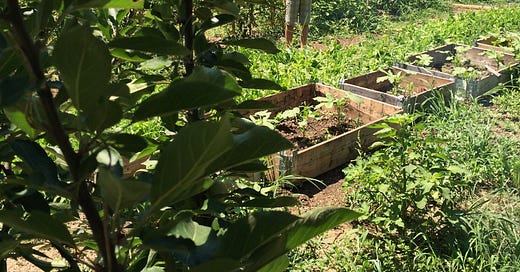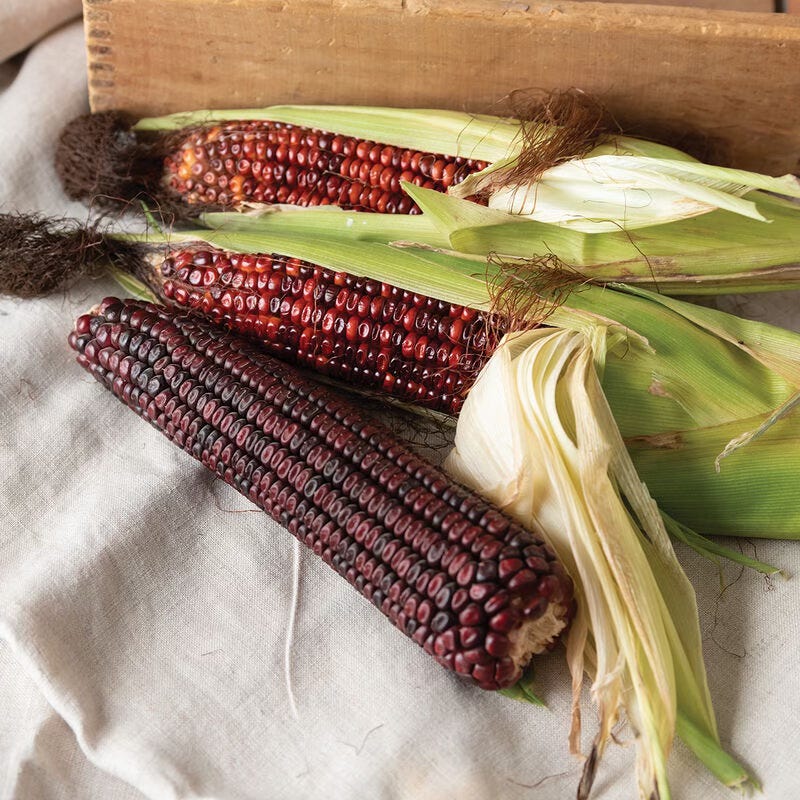Tap on that little heart in the upper life corner, please; it builds my credit with the boss.
Gardening: it’s historic and it’s humane because it goes back to our earliest, if mythological, experiences as humankind, in that great Garden of Eden where we never had to work because the fruit just fell into our eager, open mouths. Until Eve’s transgression, that is, and with that, gardening turned into a chore. Albeit for the most part, a welcome chore because it’s not only a way to put food in our mouths but also one major way to connect directly with the earth, to spread our hands in dirt and feel the life that’s there, waiting to grow.
In the third chapter of Genesis, God, after walking in the garden in the cool of the day (a nice touch, that) and discovering the First Couple’s sin, condemns Adam in these words:
[The earth] will produce thorns and thistles for you,
and you will eat the plants of the field.
By the sweat of your brow
you will eat your food
until you return to the ground,
since from it you were taken.
So that was the beginning of gardening, hoeing the earth, tilling the soil, endlessly weeding between the plants, consuming the thorns and thistles at every meal.
Still: It really doesn’t take much to start a garden, it doesn’t take much to grow a little food. Soil, sun, and water are what’s needed. That and some hard work, a little advance prep, and a willing heart.
I had this pointed out to me this morning, one of those sticky summer mornings on the coast of Maine when the temperature is not too high but the humidity (“the humdiddy,” oldtimers call it) makes it seem almost tropical. Standing in the garden of my friend David Kibbe, I had to marvel at what he has achieved in just three short years.

The site, around three-quarters of an acre, was barren when David bought it, more like an abandoned dump for piles of junk, dirt, broken asphalt, dead stuff removed from other places. Beneath all that lay rocky, gravelly, severely damaged and virtually lifeless soil. Today the mini-estate, which David has named Old Souls Farm, is terraced, subdivided, walled, and portioned into lush growing areas, topped by his own small house from which he can survey his domain: peach trees displaying an abundance of not-quite-ripe fruits; potatoes hilled up comfortably with rich black soil; tomatoes, eggplants, peppers, zucchini, and pumpkins, all reaching toward ripeness; and in the center a small meadow of native perennials--baptisia, monarda, liatris among them--to welcome the neighborhood butterflies, dragonflies, hummingbirds, and other useful critters.
Rows of green corn rise above elegantly curved raised beds that are edged with ditches filled with woodchips. This whole construction, which both controls run-off and adds valuable nutrients to the soil, is based on a thoughtful combination of bioswales (the ditches, filled with plant debris and slowly decaying rotted wood, topped with chips) and hügelkultur (a similarly layered construction, like a mounded compost heap that slowly fertilizes the upper level in which the corn is planted). The corn, by the way, is supposed to be “knee-high by the Fourth of July,” according to local mythology, but David’s corn is already hip-high and going strong.
Not everyone is able to cultivate a garden with the acuity and attentiveness that David brings to the task, but almost everyone can grow a little something, if only a window sill with a plant pot filled with parsley or basil or another favorite herb. Almost every great gardener I’ve known, when asked how they got started, will mention a childhood experience: “I never realized carrots grew in the ground until my favorite uncle showed me how and where to sow the seeds. When the tender little green leaves first appeared, I thought it was a miracle.”
Think about that if you have alert and curious children. Start them off with something that grows quickly—beans or peas are good for that. Plant just a few seeds in a corner of the garden, or in a plant pot in a sunny windowsill. Watch the first green things to come out of the ground and let them grow until the fruits begin to appear. Encourage tasting—raw vegetables taste so different from cooked ones and you might even convert your junior vegephobe into a full-fledged vegetable lover with a handful of pea pods to shuck and eat right there in the sunlight. And who knows, you may even create a gardener to take over when you get too old to do the weeding yourself.
I look back on many years of gardening, in Italy, in Maine, and a little bit in a Boston suburb where I had a narrow strip of soil and two apple trees. But I’m not much of a gardener these days, finding it just too hard to get down on my knees amid the weeds. I still grow peas (what are called “English” peas and amazingly difficult to find in markets these days) and fava beans (because it’s the only way to get them at the right stage of maturity), and I grow as much garlic as I can just for the double pleasure of harvesting early scapes and later on bulbs. Having my own garlic, stored in a dry corner of the barn, is a source of comfort—if I’ve got garlic plus some olive oil, I can make just about anything taste good. But I leave the major garden effort to younger knees and younger backs and instead I cruise the many farmstands and markets with which my part of the country is blessed.
Watching David’s garden grow, I’m reminded of another great garden, another great gardener, whom I visited many years ago near Palo Alto. That was Rosalind Creasy who was famous for what she called “Edible Landscaping.” Her books on the subject, I’m pleased to note, are still very much in print.
Creasy’s front yard in Los Altos was an amazing display of abundance, most of it entirely edible, as she treated the most ordinary vegetables as the handsome annuals they truly are, planting them as companions with flowers and vines. I cannot now remember everything she grew, but a couple of things stood out. One was the area she had squared off for a crop of wheat. Yes, wheat, the very same thing that goes into bread, the very same thing that grows in vast monocultured tracts across the plains of North America. Growing your own wheat, harvesting it, maybe grinding it or cooking it whole, is a gratifying enterprise, one that will also teach you a valuable lesson about where food comes from and why that is so important.
But there was one other vegetable in her yard that really stood out for me—tall stalks of Bloody Butcher corn. I loved the name, I loved the color of the ears (deep dark red), and I loved the thought that this was what we would later come to call a heritage crop. I went home to that narrow suburban garden in Boston, ordered seed for Bloody Butcher from Johnny’s Seeds, and proceeded to grow my own. Once it was mature, I harvested the ears, dried them thoroughly, and had them ground to a beautiful rosy cornmeal from which I made cornmeal johnnycakes for several weeks.
The recipe for Corncake below is for paid subscribers.
Keep reading with a 7-day free trial
Subscribe to On the Kitchen Porch to keep reading this post and get 7 days of free access to the full post archives.






